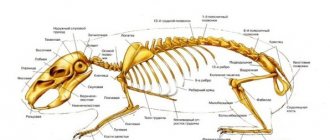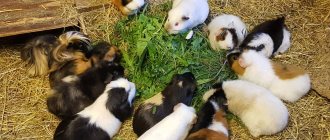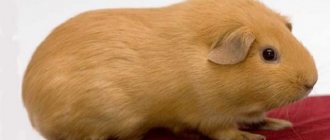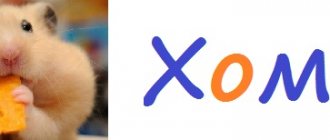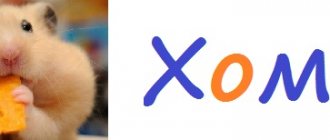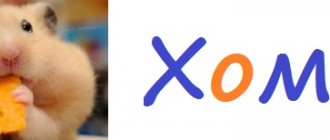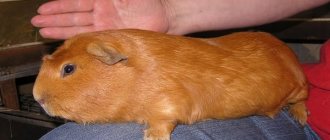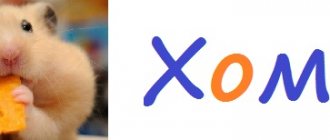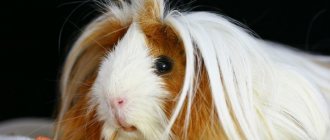Decorative guinea pigs (cavies) attract attention with the variety of acceptable colors. Among them there are often black, spotted, red and even tortoiseshell individuals. But it is white animals that at first glance give the impression of cute, defenseless creatures and are in particular demand among lovers of pet rodents. And since not every variety can have this unusual color, let’s figure out which rodents include white breeds of guinea pigs (white cavies).
Breed classification
Officially, all breeds of guinea pigs are divided into:
- Longhaired,
- Short-haired.
Rosette breed of guinea pigs
However, the types of guinea pigs also have an unofficial classification:
- Rare,
- Popular.
Not only the length and structure of the coat depends on the breed of the animal.
Short-haired Kavy breeds
A short-haired guinea pig is less demanding to care for and often animals with short hair are the best choice for a novice breeder. Cavias can be fluffy or plush, with smooth and shiny fur or even shaggy.
Satin
Satin guinea pigs differ from any other breed in the structure, gloss and special shine of their coat. Satin Cavies have smooth and very soft hair, and the colors are most often one-color or two-color. The rarest are golden, lilac and buffalo satins.
Himalayan
The Himalayan guinea pig has a very recognizable appearance and a color characteristic only of it. The main color of the Himalayan's fur is white or beige. The nose, ears and paws are colored even brown or black. Brown can have several shades - the uniformity of color and smooth transition from the lightest to the darkest are important. Any other colors are not allowed in the breed. The Himalayan is a breed of Russian selection and is very good for the first experience of breeding purebred pigs for exhibitions and shows.
Agouti
The agouti guinea pig is also one of the most popular. The colors of the animal are often monochromatic, but there are also two-color and three-color ones. Agouti have one distinctive feature - the tips of the hairs of the coat are lighter than the main color. The most common varieties you can find are silver, golden, lemon and chocolate agoutis with pink, ruby or dark eyes.
Abyssinian
The Abyssinian guinea pig also has a second name - rosette. Cavias of this breed are distinguished by the presence of characteristic rosettes of wool. Thoroughbred animals should have 8 - 10 symmetrical rosettes. The hairs in the rosettes grow in a circle and form a kind of funnel. The color of the Abyssinian can be solid, piebald, or tricolor.
Dutch
The common or Dutch guinea pig is one of the most common. Once brought from Holland, they gained wide popularity as an unpretentious breed.
These cute lop-eared animals are lighter than all other cavy. The Dutch have a two-color color: the head of the animal is darker, the paws and middle of the body are white, and the color of the back of the animal matches the color of the head. Most often, the head and back of the pig are colored black or brown, but the breed standard allows any color.
Guinea pig selfie
Where does agouti live?
Photo: Agouti rodent
The animal, Dasyprocta punctata, is commonly known as the Central American agouti and is found from southern Mexico to northern Argentina. The main part of its range extends from the state of Chiapas and the Yucatan Peninsula (southern Mexico) through Central America to northwestern Ecuador, Colombia and far western Venezuela. Highly disjunct populations occur in southeastern Peru, southwestern Brazil, Bolivia, western Paraguay, and extreme northwestern Argentina. Some species have also been introduced elsewhere in the West Indies. Agoutis have also been introduced to Cuba, the Bahamas, Jamaica, Hispaniola and the Cayman Islands.
These rodents live mainly in tropical forests and other wet areas such as swamps. It is rare to find them in the open steppe pampas. They prefer to settle in places with sufficient water. Central American agouti are found in forests, dense thickets, savannas and cultivated areas. In Peru they are limited to the Amazon region, where they are found in all parts of the low rainforest zone and in many parts of the high jungle zone (up to 2000 meters in altitude).
Agoutis are closely associated with water and are often found along the banks of streams, rivers and lakes. They often build dens and numerous sleeping areas in hollow logs, among limestone boulders, or under tree roots or other vegetation. The species is most abundant in Guiana, Brazil and northern Peru.
Now you know where the agouti animal lives. Let's see what he eats.
Long-haired breeds
Long-haired Cavias are a decoration for any exhibition, but they should only be owned by people with experience and enough free time. The coat of almost all long-haired Kaviya breeds exceeds 20 cm in length and is not so easy to care for. Some long-haired pigs have an unpleasant odor caused by the sebaceous glands. Ordinary daily care for a pig includes combing the fur two or three times and picking out sawdust, pieces of food, and dry grass from it.
Almost all breeds of pigs have long bangs, which makes eating difficult and limits vision. Therefore, they need to braid their hair or make ponytails.
Texel
Texel pigs come in a variety of colors and have long, soft fur. Often there are individuals with a coat length of about 25 cm. They are distinguished by curly hair growing from the muzzle down. Even very small rosettes are completely unacceptable.
Merino
Cavia Merinos are similar to Texels in fur growth, but their hair is wavy and there must be one rosette on the head. Merinos also come in a variety of colors. Before exhibitions, the animals' hair is curled into curlers, giving them a neat and well-groomed appearance.
Alpaca
Alpaca is a curly and long-haired breed. There are two rosettes on the back of the animal’s body. The fur grows towards the muzzle. Alpaca wool is very soft, beautiful and silky, and can reach a length of 30 centimeters or more. The animals have a wide variety of colors, but the most valuable are lemon, buffalo, roan and cream.
Alpaca guinea pig
Peruvian guinea pig tricolor
Long-haired Sheltie pig breed
Rare breeds of guinea pigs
Rare breeds include:
- Sobolinaya,
- Kui,
- Curley,
- Lunkaria.
Sobolinaya
The Kavyi sable breed was developed in England and comes in several color forms. The common sable pig is sepia-colored on the back, and the muzzle and ears have a darker, coffee-colored tint. For purebred animals, it is important that the sepia color weakens from the back to the croup, and the tummy is painted an even beige color.
In addition to the ordinary sable color, there are also other varieties:
- Sable lilac,
- Sable ferret,
- Sable Siamese.
Kui
Kui are the giants of the guinea pig world.
Cavias of this breed have been bred for many centuries as meat animals, therefore they differ from all other breeds not only in size, but also in their cautious and distrustful character. The animals are aggressive towards each other and keeping several animals in one cage leads to frequent fights. Cui babies weigh about 150-200 grams at birth, and the weight of an adult pig exceeds three kilograms. Kui come in different colors, but most often they have a wild, grayish-red color.
Curley
Curly pigs were obtained relatively recently in Sweden. Curly is a new gene responsible for chaotic hair growth, giving the animal a funny and shaggy appearance. The Curley gene is dominant and is well passed on through generations. Curley Kawis are short-haired, although outwardly the fur looks very long. Any solid colors are allowed.
Lunkaria
The cutest and rarest guinea pigs, Lunkaria, come from Sweden. Lunkaria was obtained recently and is not yet recognized by all international associations as an independent breed. However, in Sweden, Norway, Denmark and England, kavias take part in exhibitions and are gaining increasing popularity. The pigs were bred by crossing Curley and Peruvian pigs. From the Curley they inherited the gene for hair growth, and from the Peruvians they inherited a long and smooth coat. The colors of the animals can be absolutely any.
General feeding rules
The recommended daily ratio of all types of food looks like this:
- dry food – 5-10% (no more than a tablespoon);
- juicy food – 30%;
- hay – 60%.
If there is no dry food on the menu, an adult pig should eat approximately 150 g of vegetables per day . She is served vegetables every day, and is occasionally pampered with berries and fruits. Vegetable dishes must be supplemented with leafy greens, which compensate for the lack of vitamins.
Do not keep your rodent on a mono-diet, feeding it only carrots or beets: this will cause health problems. It’s great if there are different products on his table every day: parsley will be replaced by dill/basil, and celery by carrots/zucchini. A typical daily diet consists of three types of vegetables and herbs.
Important! Do not collect plants near highways, factories, or in swampy areas. Dry the grass for at least 1.5-2 months: it should not be blackened or rotten.
Do not forget to establish an uninterrupted supply of hay (especially during the cold period): the guinea pig chews it constantly, without limiting itself in volume. Hay normalizes digestion and is necessary for proper grinding of teeth.
Legume and legume-cereal hay is considered the most valuable. The rodent will also thank you for the vitamin herbs (nettle, alfalfa and clover) that you will prepare in the summer. These plants will be an excellent feed for growing and pregnant animals.
Albinos and dwarf pigs
There are many myths that albinos have poor health and are rejected from many breeds. This statement is wrong. An albino is a guinea pig with pink or blue eyes and a complete absence of coloring pigment. In many breeds, albinos are bred and recognized as distinct color forms. Thus, albinos are quite common among Selfies, Himalayans, and Teddies. A white guinea pig with pink eyes can be either a Texle or an Agouti.
The only thing that can affect the health of albino animals is inbreeding in pursuit of fixing eye color, especially if they are blue.
The second myth concerns the existence of dwarf guinea pigs. Cavias are not dwarf. There are some breeds that are slightly smaller in size. These breeds include Dutch pigs or Teddies. In some litters you can find smaller cubs, which are characterized by slower growth and even as adults remain much smaller than their counterparts. In this case, it is worth talking not about dwarfism, but about the fact that a genetic deviation and developmental delay have occurred. Such cavy cannot be used for further breeding.
Teddy guinea pig breed
Argents
The colors of the argents must be very clear, otherwise they will blend together. Especially pigs with white tips of their fur look monochromatic. In long-haired pigs, zonation of fur can only be seen on the head, where the hair is short.
Argents come in the following colors:
Lilac-golden.
The main zone is purple, the tips and belly are a rich golden color. The eyes are orange-red. The ears and paw pads are pink, the claws are light. Genetic formula: AA BB CC EE pp
Beige-golden.
The main color is beige, the tips and belly are golden. The eyes are orange-red. The ears and paw pads are pink, the claws are light. Genetic formula: AA bb CC EE pp
Slate blue-gold argente.
The main color is slate blue, the tips and belly are golden. The eyes are ruby, the ears and paw pads are gray-blue, the claws are dark. Genetic formula: AA BB CC EE prpr
Lilac-safran-argente.
The main color is lilac, the tips and belly are saffron. The eyes are orange-red. The ears and paw pads are pink, the claws are light. Genetic formula: AA BB cdcd EE pp
Beige-safran-argente.
The main color is beige, the tips and belly are saffron. The eyes are orange-red. The ears and paw pads are pink, the claws are light. Genetic formula: AA bb cdcd EE pp
Slate-blue-safran-argente.
The main color is slate blue, the tips and belly are saffron. The eyes are ruby, the ears and paw pads are gray-blue, the claws are dark. Genetic formula: AA BB cdcd EE prpr
Purple-white argents.
The main color is purple, the tips and belly are white. The eyes are orange-red. The ears and paw pads are pink, the claws are light. Genetic formula: AA BB crcr EE pp
Beige-white argents.
The main color is beige, the tips and belly are white. The eyes are orange-red. The ears and paw pads are pink, the claws are light. Genetic formula: AA bb crcr EE pp
Slate-blue - white.
The main color is slate blue, the tips and belly are white. The eyes are ruby, the ears and paw pads are gray-blue, the claws are dark. Genetic formula: AA BB crcr EE prpr
How to find out the breed
When purchasing an animal at a pet store or online, you need to know how to determine the breed of guinea pig. This is necessary so as not to buy the most ordinary animal under the guise of a rare cavy with an unusual color. You can learn about the breeds on numerous sites and forums of pig breeders, where detailed descriptions of the animals with photographs are given. You can also contact clubs for explanations of the characteristics of a particular Kavy breed.
Skinny guinea pig breed
Baldwin breed of hairless pigs
Breeders are willing to share information. However, some breeds of animals are recognizable: Teddy has plush fur and looks more like a toy, Skinny has no hair at all, and Alpacas have funny curls. Which breed is best to choose in the end depends on capabilities and personal preferences.
What does agouti eat?
Photo: Agouti in nature
The animals mainly feed on fruits and during their daily excursions they look for fruit-bearing trees. When food is plentiful, they carefully bury the seeds to use as food when fruit becomes scarce. This behavior helps in sowing seeds of many species of forest trees. These animals often follow groups of monkeys and collect fruits dropped from trees.
Interesting Fact: It has been recorded that agoutis can hear fruits falling from trees from afar and are attracted to the sound of ripe fruits falling to the ground. Therefore, rodent hunters have come up with an effective way to lure out the animal. To do this, they throw a stone on the ground, simulating falling fruit.
The animals sometimes eat crabs, vegetables and some succulent plants. They can deftly break hard Brazil nuts, so the animals are very important for the spread of these plant species in the environment.
The main diet of agouti consists of:
- nuts;
- seeds;
- fruits;
- roots;
- leaves;
- tubers.
These rodents help restore forests, just like native squirrels. But they can also cause significant damage to sugar cane plantations and banana plantations, which they use for food. As more forested land is converted to agricultural purposes, agoutis increasingly consume the crops of local farmers. Agoutis feed by sitting on their hind legs and holding food in their front legs. They then turn the fruit over several times while cleaning it with their teeth. If there are any remaining parts of the fruit that are not eaten at the end of the meal, the agouti hides them.
